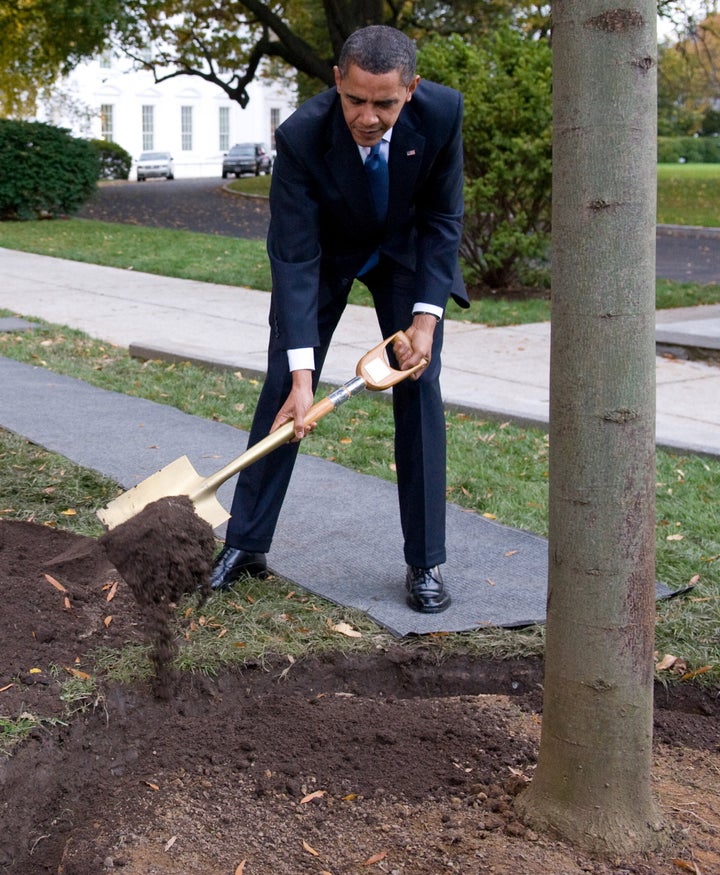
NEW YORK -- As President Barack Obama pushes for his American Jobs Act, some on the right and in the press have claimed there are no "shovel-ready" projects in the United States available to receive federal funding.
The state transportation departments who are on the front line of infrastructure spending, however, strenuously disagree. And some economists say we'll be enduring the downturn for so long that the question of whether the new jobs associated with the projects are created within the next 12 months, while an important political consideration, is almost irrelevant in economic terms.
The president's bill contains $105 billion for road-building, school modernization and more. Republicans have argued the money that has been spent so far on infrastructure has been wasted.
“Don’t forget, the president made the same promises when he was selling his first stimulus," Senate Minority Leader Mitch McConnell (R-Kentucky) said on the Senate floor. "Yet 2 1/2 years later what do we have to show for it?”
And attaining Congress's approval for all that money wasn't made any easier when the president joked in June that sometimes during the stimulus "shovel-ready was not as shovel-ready as we expected." But states say they're ready to go.
"We feel certain that we would have projects ready to go if we received additional funding," said Sally Oxenhandler, a spokesperson for the Missouri Department of Transportation. "We do have a five-year construction program that's a rolling program. We have quite a few projects in the hopper that we would be able to move up."
Oxenhandler noted that when the American Recovery and Reinvestment Act was signed in 2009, her department went to start replacing a Depression-era bridge the very same day.
It's hard to find a state transportation department that says it couldn't put more money to use in 2012. That comes as no surprise to Jack Basso, Director of Program Finance and Management at the American Association of State Highway and Transportation Officials (AASHTO).
In 2010, AASHTO surveyed its members on the size of their unfunded project backlogs and found that they could use almost $50 billion for highways alone (the Recovery Act put $27.5 billion more towards those big roads).
"I bet the number's considerably bigger at this point," Basso said. "I'm quite confident that we haven't drained the swamp."
Transportation authorities across the country rely on gas tax dollars to build highways and bridges, but the gas tax is not tied to inflation and hasn't been raised since 1993. So many states are struggling to pay for projects.
As Basso explained it, for some projects in state transportation pipelines, it would only take 30-60 days for Federal Highway Administration approval and then another 30 days for states to put out bids. That's an ideal timeline. While some of the big-ticket projects -- the Hoover Dams of the infrastructure world -- might require those much-dreaded environmental approvals, others have already received federal approval but are waiting on financing.
Scott Magruder of the Nevada Department of Transportation said that with more money, his department could complete the Carson City Freeway and the first phase of the Boulder City Bypass, near Las Vegas. Both projects cost about $100 million each.
"Those are ready to go, and unfunded, and the environmental process is complete," Magruder said. "The right of way's all purchased, the environmental's all done, it's just waiting on funding."
Arizona is also waiting.
"The Arizona Department of Transportation recently submitted to the Federal Highway Administration eight projects totaling $423,448,000 that are considered ready-to-construct," said Timothy Tait, an assistant communication director. "These projects include a new urban freeway in metro Phoenix, interstate highway expansion, rural highway enhancements and a bridge replacement."
And there are plenty of other, smaller public works projects across the U.S. that could use a few extra dollars.
"On Monday we're advertising for design firms to do design work on a 187 small bridges. Obviously, with more money we could do more of that. We have tremendous needs all across the state," said Nicole Meister, a spokesperson for the North Carolina Department of Transportation.
"We have a lot of needs here," she noted. "Some projects yes, are big projects that require more environmental work. Others are small projects like small bridge replacements."
"You do get into situations where we have projects ready to go but don't have funding yet," she added.
Moody's Analytics estimates that for every $1 spent on infrastructure spending the government creates $1.59 in economic growth. But some of that multiplier effect may be diminished when projects take too long to go through government approvals, according to US News and World Reports.
Macroeconomic Advisors, another analysis firm, estimates that the federal government would put out the infrastructure money relatively quickly: "2/5 of this money will be spent by the end of 2012, 2/3 of it by the end of 2013, and the rest over the next several years."
The delay might not matter much, except to politicians looking ahead to re-election, if, as the Congressional Budget Office estimates, the country doesn't return to its "natural rate of unemployment" until 2016.
"This is not a normal recession, [where] all of sudden we're gonna have a huge amount of stimulus and be back to full employment," said Ethan Pollack, a senior policy analyst at the Economic Policy Institute. "I dream of having that problem -- 'Oh no! Too many people are employed!' "
"There is a balance between getting the money out quickly and getting the money out to good projects -- so there's a certain lag time," Pollack added.
And the argument against more infrastructure funding, "basically rests on the assumption that we shouldn't be doing it if the economy is better," he noted.
The president claimed in his address on the American Jobs Act that it "answers the urgent need to create jobs right away." But he also added that Congress needed "to look beyond the immediate crisis and start building an economy that lasts into the future."
The American Society of Civil Engineers thinks the country needs to spend $2.2 trillion over the next five years to get our bridges, dams, pipes, railroads and levees in shape.
Still, the amount of money proposed in the American Jobs Act for infrastructure spending -- some $105 billion -- sounds big, but even by the most optimistic estimates would only put a modest dent in our current, sky-high unemployment level.
David Obey, the former Democratic chairman of the House Appropriations Committee, said "you cannot expect a jobs package to perform a miracle. All it can do is help around the edges."
Factors beyond U.S. control, like the debt crisis in the Euro-zone, may determine more than infrastructure spending how fast we put people back to work.
But the recession is "going to be with us a long time," Obey noted. "So we ought to do anything we can to tee these projects up. No matter what we do, it's better than doing nothing."
CORRECTION: An earlier version of this article incorrectly stated that the Missouri Department of Transportation began work repairing a Depression-era bridge in 2009. In fact, the department worked to replace the bridge.
